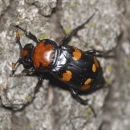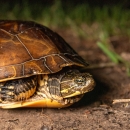Featured Species
With over 112 counties and a variety of habitats within our area of responsibility, the Fort Worth Sub-office relies heavily on volunteers, partners, state and federal agencies, and interested stakeholders to help conserve and protect natural resources. We work on at-risk species, including migratory birds, fishes, mussels, reptiles, mammals, and plants. Avian species include the lesser prairie chicken, black-capped vireo, and red-cockaded woodpecker. Fish species include the Arkansas River shiner, sharpnose shiner, and smalleye shiner. Invertebrates include freshwater mussels, such as the Louisiana pigtoe and Texas heelsplitter. Other species we focus on include alligator snapping turtle, Texas kangaroo rat, and native plants, including a tiny herbaceous plant known only by its scientific name, Geocarpum minimum.

















